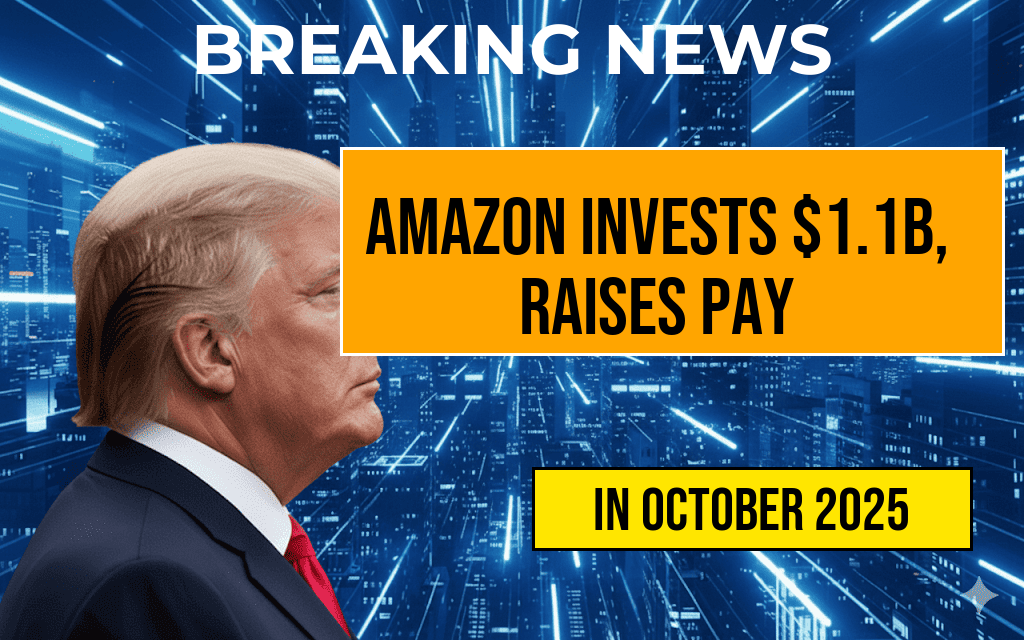Amazon has announced a significant investment of $1.1 billion aimed at increasing pay for its fulfillment center workers across the United States. The company reported that this capital infusion will elevate the average hourly wage for these employees to over $23 an hour, marking one of the largest wage increases in Amazon’s history. The move reflects Amazon’s ongoing efforts to address labor concerns and improve working conditions amid intensifying competition for warehouse staff. The investment is expected to impact thousands of workers, with the company emphasizing its commitment to offering competitive compensation and benefits. This strategic financial boost also coincides with broader industry trends toward higher wages in logistics and fulfillment sectors, driven by labor shortages and increased consumer demand.
Details of the Investment and Wage Increase
Scope and Distribution
Amazon’s $1.1 billion investment will be allocated across its network of fulfillment centers, delivery stations, and sortation hubs nationwide. The company has indicated that the wage hike will be phased in over the coming months, affecting more than 500,000 employees. The adjustment aims to make Amazon’s compensation packages more competitive within the logistics industry, which has seen a surge in wage offers from rival retailers and courier services.
Impact on Workers
Employees working in Amazon’s fulfillment network will see their hourly pay rise to an average of over $23, with many earning even higher wages depending on location and seniority. This marks a notable increase compared to previous averages, which hovered around $18 to $20 per hour in several regions. Amazon’s move also includes enhancements to benefits such as healthcare, paid time off, and career development programs, reinforcing its effort to retain talent amid a tight labor market.
Industry Context and Labor Market Dynamics
Competitive Pressures and Recruitment Challenges
The logistics sector has faced intense competition for warehouse and delivery personnel, especially during the pandemic-driven surge in online shopping. Companies like Amazon, FedEx, and UPS have increased wages and improved benefits to attract and retain workers. According to data from the U.S. Bureau of Labor Statistics, employment in warehousing and transportation has expanded rapidly, but the demand for skilled labor continues to outpace supply.
Broader Industry Trends
Amazon’s wage increase aligns with a broader industry shift towards more sustainable compensation strategies. Several logistics companies have announced similar initiatives, recognizing that higher wages can reduce turnover and improve operational efficiency. Experts suggest that such investments are critical as e-commerce sales grow steadily, with the e-commerce industry poised for further expansion.
Financial Implications and Company Strategy
| Category | Amount (in USD) | Description |
|---|---|---|
| Wage Increase | $700 million | Direct payroll enhancements for fulfillment workers |
| Benefits Improvement | $250 million | Enhancements to healthcare, paid leave, and career programs |
| Operational Upgrades | $150 million | Technology and infrastructure improvements to support increased wages |
| Training and Development | $100 million | Upskilling initiatives for warehouse staff |
Strategic Goals and Future Outlook
Amazon’s investment underscores a strategic shift towards prioritizing employee retention and operational resilience. By offering higher wages and improved benefits, the company aims to reduce turnover rates, which have historically been high in fulfillment centers. Industry analysts suggest that such investments could lead to long-term savings through increased productivity and reduced recruitment costs. Additionally, Amazon’s focus on workforce stability may set a benchmark for other e-commerce giants facing similar labor market pressures.
Reactions and Industry Implications
Labor advocates have welcomed Amazon’s wage hike as a positive development in an industry often criticized for low pay and demanding work environments. However, some critics argue that wage increases alone do not address broader issues related to workplace safety and job satisfaction. Amazon’s move may also influence competitors to follow suit, potentially elevating industry standards for fulfillment center compensation.
Worker Perspectives
- John Davis, a warehouse worker in Ohio, stated, “This raise makes a real difference for my family. It shows Amazon is finally recognizing our hard work.”
- Maria Lopez, a recent hire in Texas, noted, “Higher wages and benefits make me feel more valued and motivated to stay long-term.”
Looking Ahead
With the initial phase of the wage increase underway, Amazon is expected to monitor its impact on operational efficiency and employee satisfaction. The company’s ongoing investments in workforce development and automation technologies suggest a comprehensive approach to balancing labor costs with service excellence. As the industry continues to evolve, Amazon’s recent move may serve as a catalyst for broader reforms within the logistics and e-commerce sectors, emphasizing sustainable employment practices and competitive pay structures.
Frequently Asked Questions
What is the total amount Amazon has invested in its fulfillment workforce?
Amazon has invested a total of 1.1 billion dollars to improve conditions and compensation for its fulfillment workers.
How has Amazon’s investment impacted the average pay for fulfillment workers?
The investment has boosted the average pay for fulfillment workers to over twenty-three dollars an hour.
Which areas or aspects of Amazon’s fulfillment operations are most likely to benefit from this investment?
This significant investment primarily benefits fulfillment workers through higher wages, enhanced working conditions, and potentially better benefits.
When did Amazon make this investment, and what prompted this move?
While the exact date is not specified, the 1.1 billion dollar investment reflects Amazon’s ongoing efforts to improve employee compensation and retain its workforce amidst industry challenges.
How does Amazon’s pay increase compare to industry standards for fulfillment workers?
With an average pay now exceeding twenty-three dollars an hour, Amazon’s compensation levels are competitive and aim to attract and retain skilled fulfillment workers in the industry.





